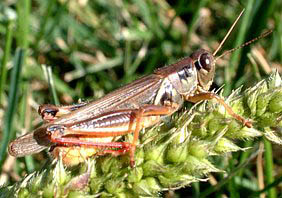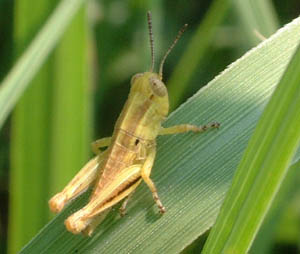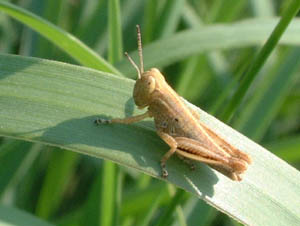G1630
A Guide to Grasshopper Control on Rangeland
This NebGuide discusses effects of grasshoppers on rangeland, how to manage rangeland to minimize grasshopper impact, how to monitor grasshopper populations, and how to select and apply insecticides registered for grasshoppers when control measures are needed.
P.E. Reece, Extension Rangeland Entomologist
G.L. Hein, Extension Entomologist
- Life Cycle
- Temperature Relationships
- Defoliation Effects
- Grazing Management Objectives
- Herbage Allocation
- Plant Communities
- Best Grazing Management Practices
- Monitoring Hopper Populations
- Chemical Control
- Reduced Agent/Area Treatment (RAAT)
- Barriers
- Baits
- Further Information
 |
Redlegged Grasshopper |
Grasshoppers can cause damage anywhere, but do so most frequently in areas with less than 25 inches of annual rainfall. In most years, the western two-thirds of Nebraska falls into this rainfall category and can be subject to severe grasshopper outbreaks.
About 50 species of grasshoppers are found on rangeland in Nebraska; however, generally fewer than 10 species ever reach economic importance, causing about 95 percent of the damage. These are whitewhiskers, striped, slantface, largeheaded, Elliott, whitecross, migratory, spottedwing, kiowarange, and fourspotted grasshoppers. Grasshoppers defoliate grasses by direct feeding on leaf and stem tissue and by cutting off leaves or stems and heads while feeding. High populations of grasshoppers on rangeland can damage plant crowns so severely that many grass plants will not recover. With the exception of the migratory grasshopper, rangeland grasshopper species rarely feed on crops, except during years of very high populations.
Life Cycle
There are three stages in the grasshopper life cycle — the egg, nymph, and adult. The number of egg pods deposited by a single female may range from 7 to 30 with 8 to 30 eggs per pod, depending on the species. The eggs are well insulated with a frothy, sticky substance that is excreted when eggs are deposited, and allows them to survive extremely cold temperatures. Some grasshoppers prefer to lay eggs in soil surrounded by grass roots, while other species select open areas with accumulations of surface debris.
Most grasshoppers overwinter in the egg stage, but a few species hibernate as 3rd instar nymphs. Most of these species are “band-wings,” large grasshoppers seen early in the spring that make a crackling noise during flight, but one, the velvetstriped grasshopper, is a small, slantface grass feeder. These species are normally few in number and do not seriously damage rangeland. However, occasionally a serious infestation of these overwintering species causes heavy range damage.
Hatching time (late May and June for most important species) is influenced by weather. Most nymphs start feeding within one day after egg hatch and usually feed on the same plant species as the adult. Because of limited fat reserves, young nymphs are the most vulnerable to adverse weather conditions. Extended cool temperatures (less than 65°F) and rainy weather during early hatching will result in starvation of the young nymphs and reduced populations during the rest of the summer.
Grasshopper nymphs generally develop to the adult stage in six to eight weeks. Grasshoppers begin egg-laying one to three weeks after becoming adults. They may live two months or longer, depending on late summer and early fall weather.
Temperature Relationships
It is difficult to predict grasshopper development from air temperatures because grasshoppers can regulate their body temperature by moving from plant shadows to bare soil or open areas. Grasshopper activity and feeding begin as temperatures in their micro-habitat rise above 65-70°F. Growth begins earlier and progresses more rapidly on heavily defoliated rangeland, compared with properly managed rangeland.
Cool-season grasses such as needlegrass, wheatgrass, and bluegrass begin growth before the spring-hatched grasshoppers become active in late May and June and grow most rapidly when air temperatures are 65-75°F. By the time grasshopper infestations begin to heavily defoliate plants, cool-season grasses have completed their growth and recharged energy reserves needed for spring growth next year. Occasionally, the overwintering population is numerous enough to destroy the cool-season grasses. Warm-season grasses such as bluestems, grama grasses and buffalograss do not begin growth until May and grow most rapidly when temperatures are 85-95°F. Consequently, spring-hatched grasshoppers are most likely to damage warm-season grasses because they don’t complete their growth until late summer.
Defoliation Effects
Understanding how grasses respond to defoliation is critical for grasshopper management on rangelands. Each year rangeland vegetation is defoliated by livestock, wildlife, insects, hail and/or fire. Grasshoppers can rapidly remove a large percentage of the foliage. Root growth stops and nutrient uptake is reduced for several days when more than half of the green herbage is removed from grasses. Lengths of “shut-down” and “slow-down” periods in roots increase as severity and frequency of defoliation increase. Removing more than 65 percent of the green herbage one time during the growing season can reduce total root length by 30 percent or more. When grasses are severely defoliated over several years by any combination of processes, plants become weak and die. Grasses in excessively defoliated pastures are drought stressed, even when precipitation is near average, because reduced root length limits access to available soil moisture.
Grazing Management Objectives
- Make the environment as unfavorable as possible for the growth and survival of pest species of grasshoppers.
- Maintain high levels of plant vigor and range condition to minimize the effects and occurrence of outbreaks.
Grasshoppers are small and cold-blooded and therefore, profoundly affected by temperature and relative humidity in their micro-habitat. All developmental stages of grasshoppers can be accelerated by high temperatures or retarded by low temperature. Increasing the time required for grasshoppers to mature increases juvenile mortality, which reduces defoliation and the number of eggs produced for the next year’s grasshopper population.
Temperatures and relative humidity near the soil surface are directly related to the height and distribution of herbage. Increases in herbage that delay grasshopper growth also provide habitat for natural predators and pathogens, including birds, mammals, reptiles, predatory insect species, fungi and other pathogens. Management practices that minimize favorable habitat for pest species of grasshoppers also maintain high levels of plant vigor and range condition. The number of grasshopper species and the total number of grasshoppers may be greater on properly managed prairie compared with overgrazed prairie; however, reduced grasshopper growth rates, higher mortality of immature grasshoppers and higher productivity of plants minimize the effects of these populations.
Herbage Allocation
Soil can be shaded or insulated from direct sunlight with standing herbage or litter. On healthy rangeland, standing herbage consists of a mixture of residual herbage from preceding years and current-year herbage. A minimum amount of standing herbage must be retained at all times for protection against erosion and to enhance infiltration of precipitation. About half of the herbage produced each year is needed to maintain levels of residual cover typical of healthy rangeland. Disappearance of the other half by the end of the summer grazing season results from nearly equal defoliation by cattle and natural processes. On properly stocked rangeland, cattle will use about 25 percent of the current-year herbage resource.
Published estimates of herbage reduction caused by grasshoppers are highly variable. While these insects are a natural part of range ecosystems, herbage losses caused by outbreaks must be offset by reduced livestock use. Estimates of daily dry matter intake for grasshoppers range from 30 percent to 250 percent of body weight compared with 1.5 percent to 2.5 percent for beef cattle. A 1,250 lb cow would therefore consume 19 to 31 lb herbage each day. The same amount of herbage could be consumed by 8 to 104 lb of grasshoppers. Many ranchers develop a mental picture of what pastures should look like when it is time to remove livestock. Cattle should not be placed in grasshopper-infested pastures that appear to be near or below the amount of cover envisioned as adequate. Consequently, grazing is not recommended until vegetation increases after grasshopper outbreak situations have been controlled.
Plant Communities
Opportunities to shade the soil surface with standing herbage increase as composition of mid- and tallgrasses increases. Full growing-season grazing deferment from green-up to killing frost can dramatically increase mid- and tallgrass herbage production after one to five drought-free years of overgrazing. The probability of increasing shade by improving range condition or plant vigor declines as the history of abuse increases. Decades of overgrazing can reduce mid- and tallgrass prairies to shortgrass-dominated pastures that do not respond well to best management practices. Deterioration of rangeland is accelerated when drought and heavy defoliation are combined.
Best Grazing Management Practices
Cattle should be excluded for one year from pastures that are severely defoliated to replenish residual herbage and to provide uninterrupted plant growth for maximum replenishment of roots and energy reserves. It may be necessary to rest a pasture for an additional year if precipitation is below average, or if the vegetation is heavily defoliated by other processes during deferment.
Recovery of plant vigor is maximized with full growing-season deferment and is not affected by dormant-season grazing at proper stocking rates. Grazing practices that alternate the season of grazing or shift summer grazing dates by 30 days or more among pastures prevent repetitively favoring the same pest species of grasshopper in consecutive years. Periodically changing grazing between growing and dormant seasons will change grasshopper environments dramatically and maintain high levels of plant vigor. Pastures should be grazed only once from June to August to avoid severe defoliation of warm-season grasses. Grazing is generally distributed more uniformly throughout pastures with rotation when compared with continuous grazing. Consequently, rotation grazing at proper stocking rates will minimize the development of large open areas near water that are common to continuously grazed summer pastures.
Monitoring Hopper Populations
 |
 |
Nymph Grasshoppers |
Economic thresholds for grasshopper densities in pastures or rangeland vary from 8 to 40 grasshoppers per square yard. The thresholds are influenced by several factors, including the cost of insecticide treatment and projected forage yield and the value of the area being considered for treatment. These and other factors are considered in a computer program called “Hopper” that can be used to determine the treatment thresholds for individual fields. Decision support software for rangeland grasshopper management was developed by USDA-APHIS and can be accessed at http://www.sidney.ars.usda.gov/grasshopper/Support/index.htm.
Sweep net sampling is useful in determining the stage (instar) and species makeup of grasshopper populations. A standard sweep net equipped with a heavy cloth net should be used. Information from sweep net samples is particularly valuable early in the season for determining the stage of grasshopper development to optimize treatment timing, and for estimating the potential for damaging infestations to develop.
The best method for determining grasshopper density in field borders or hatching areas is to count the number of grasshoppers and use the square-foot method. With practice, this approach can provide good estimates of hopper density. To use this method, randomly select an area several feet away and visualize a one-square foot area around the spot. When first learning this method, practice with a measured square-foot area to improve your ability to visualize the counting area. Walk toward this spot while watching this square-foot area and count the number of grasshoppers that you see in or jumping out of this area. Repeat this procedure 18 times and divide the total number of grasshoppers you saw by two. This will give you the number of grasshoppers per square yard (9 square feet). Counting sites should be 50-75 feet apart and chosen at random. Just after hatching, when grasshoppers are small, they will be difficult to see, and you likely will underestimate the true hopper density. When sampling, try to vary the vegetation in the count area and sample both north- and south-facing slopes.
Chemical Control
If control is needed, insecticides are most effective when applied to grasshopper hatching areas while hoppers are in early nymphal stages. If populations are reduced to less than one grasshopper per square yard, control measures may not be needed for several years unless the area is reinfested through migration from other infested areas.
Grasshoppers may be controlled by applying insecticides as sprays or baits. The insecticides currently registered for use on rangeland are dimilin, malathion, and carbaryl (Sevin). Rates for these products are listed on the labels. If larger grasshoppers are targeted, the higher-labeled rates should be used. Other insecticides are labeled for control of grasshoppers in forages, grasses, alfalfa, and other crops. See the NebGuide, A Guide to Grasshopper Control in Cropland (G1627) for control information in these situations. Read labels thoroughly before using any insecticide and observe safety and grazing restrictions.
Reduced Agent/Area Treatment (RAAT)
Recent research at the University of Wyoming has demonstrated the effectiveness of a new grasshopper control strategy in rangeland. The strategy is to reduce both the amount of insecticide and the area treated, and is termed Reduced Agent/Area Treatment (RAAT).
The following treatment tactics have been developed by researchers at the University of Wyoming and most often optimize economic returns and are recommended by the National Grasshopper Management Board:
- Apply carbaryl (Sevin XLRI) at a rate of 8 fluid ounces per acre (= 113 grams of active ingredient) with an equal volume of water at pH 7 in I 00-foot swaths, alternating with 100-foot untreated swaths (compared with the traditional approach of using 16 fluid ounces per acre in a blanket coverage).
- Apply diflubenzuron (Dimilin 2L) at a rate of 0.75 fluid ounce per acre (= 5.3 grams of active ingredient) with 8 fluid ounces of water and 4 fluid ounces of oil in 100-foot swaths, alternating with 100-foot untreated swaths OR apply at a rate of I ounce per acre with 16 ounces of water and 8 ounces of canola oil, in 100-foot swaths alternating with 200-foot untreated swaths (compared with the standard approach of using I fluid ounce per acre in a blanket coverage).
- Apply malathion (Fyfanon) at a rate of 4 fluid ounces per acre (= 138 grams of active ingredient) in 100-foot swaths, alternating with 25-foot untreated swaths (compared with the traditional approach of using 8 fluid ounces per acre in a blanket coverage).
Higher rates and greater coverage may be needed if treatments are applied to infestations of later instars or adults. Adding canola or corn oil rather than crop oil as a carrier may increase the effectiveness of the treatment because these oils are grasshopper feeding attractants.
University of Wyoming entomologists have evaluated the use of all-terrain vehicles (ATVs) for application of pesticides using the RAATS concept. This technique relies on the same strategy as for aerial RAATs described above. Alternating swaths are sprayed and left unsprayed, but because of the smaller scale used with ATVs, lower coverage can be tolerated and maintain good control. Coverage should range from a low of 20 percent to as high as 50 percent based on the density of grasshoppers controlled. This means that for an ATV sprayer with a 15-foot spray width, the untreated swaths would range from 15 feet for extremely high grasshopper densities (40-50 per yard2) to 60 feet for lower densities (15-20 per yard2) . This application method, if carried out properly, will provide 80-95 percent control and reduce costs up to 75 percent. More information on RAATs application can be found on the University of Wyoming Web site referenced below.
Barriers
Ranchers also may need to consider protection-spraying “barriers” around valuable forage production areas such as highly productive hay meadows or seeded crops such as alfalfa or annual forages. Protection spraying may require continual surveys during the summer. As the vegetation on upland range sites matures or dries, grasshoppers will move into areas with succulent vegetation. Spraying at two- or three-week intervals may be necessary to protect these valuable forage resources.
Baits
Baits, once the most popular control method, have been replaced by insecticidal sprays. Occasionally, however, baits are used on rangeland with short, dry vegetation. Carbaryl (Sevin) 5 percent bait is available. Control of some grasshopper species will be severely limited because they will not feed on the bait. For successful control, this method requires uniform distribution of bait and re-application if the bait no longer is attractive to the grasshoppers. Attractiveness of the bait will be substantially reduced by rain or heavy dew.
Further Information
Pesticide registrations are constantly changing. Updated lists of pesticide registrations for various crops and rangeland can be found at the following Web sites:
High Plains Integrated Pest Management Guide: http://www.highplainsipm.org/
University of Nebraska: http://entomology.unl.edu
The following Web sites contain extensive information on grasshoppers and grasshopper management:
University of Wyoming: http://www.sdvc.uwyo.edu/grasshopper/
USDA-ARS: http://www.sidney.ars.usda.gov/grasshopper/index.htm
| To simplify technical terminology, trade names sometimes may be used. No endorsement of products is intended nor criticism implied of products not mentioned. |
Visit the University of Nebraska–Lincoln Extension Publications Web site for more publications.
Index: Insects and Pests
Other Pests
Issued July 2006